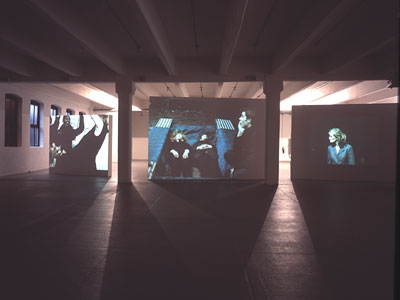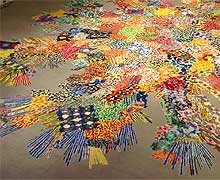
Astrid raises an interesting point about the ICA’s cavernous space and its effect on Polly Apfelbaum’s work. [See her post of July 9.] The museum’s ambiance downstairs is more like an airplane hangar than a gallery. (DIA‘s space in Chelsea seems this way, too. Image of Dia’s Rosemarie Trockel exhibit — closed for the summer, re-opening in October.) What seems to work best in these spaces is art that becomes an airplane, that is, art that’s “big” enough to create a wow in and of itself. (Last year’s Space 1026 installation did this, as did the Wall Power show and Bruce Yanemoto’s video fireworks, to name a few.)
What also works is art that creates intimacy with the viewer–art that makes the space irrelevant. Charles LeDray drew you in with his small, intricate pieces focussed on the human body. Even Lisa Yuskavage did this. Her work focussed on such private aspects of the body that it forced aside all thoughts about the ICA’s external space. Who cared?
Apfelbaum’s floor-bound work (See image of “Reckless”) is neither an airplane nor is it particularly intimate. With the exception of “Bones” and “Compulsory Figures,” both of which evoke the body directly as a vulnerable, mortal object, the rest of the work is like the Milky Way, beautiful and fascinating but outside the human experience.
That said, I loved it all. But I think Astrid is right that Apfelbaum’s pieces, which look quite different in more intimate spaces, didn’t get their best showing in the big space.
Come to think of it, the piece that works best in the ICA might be the wallpaper which creates a hazy veil of color and makes the walls fade away. It’s a stealth bomber if you will. Apfelbaum’s work is at the ICA until July 27.









